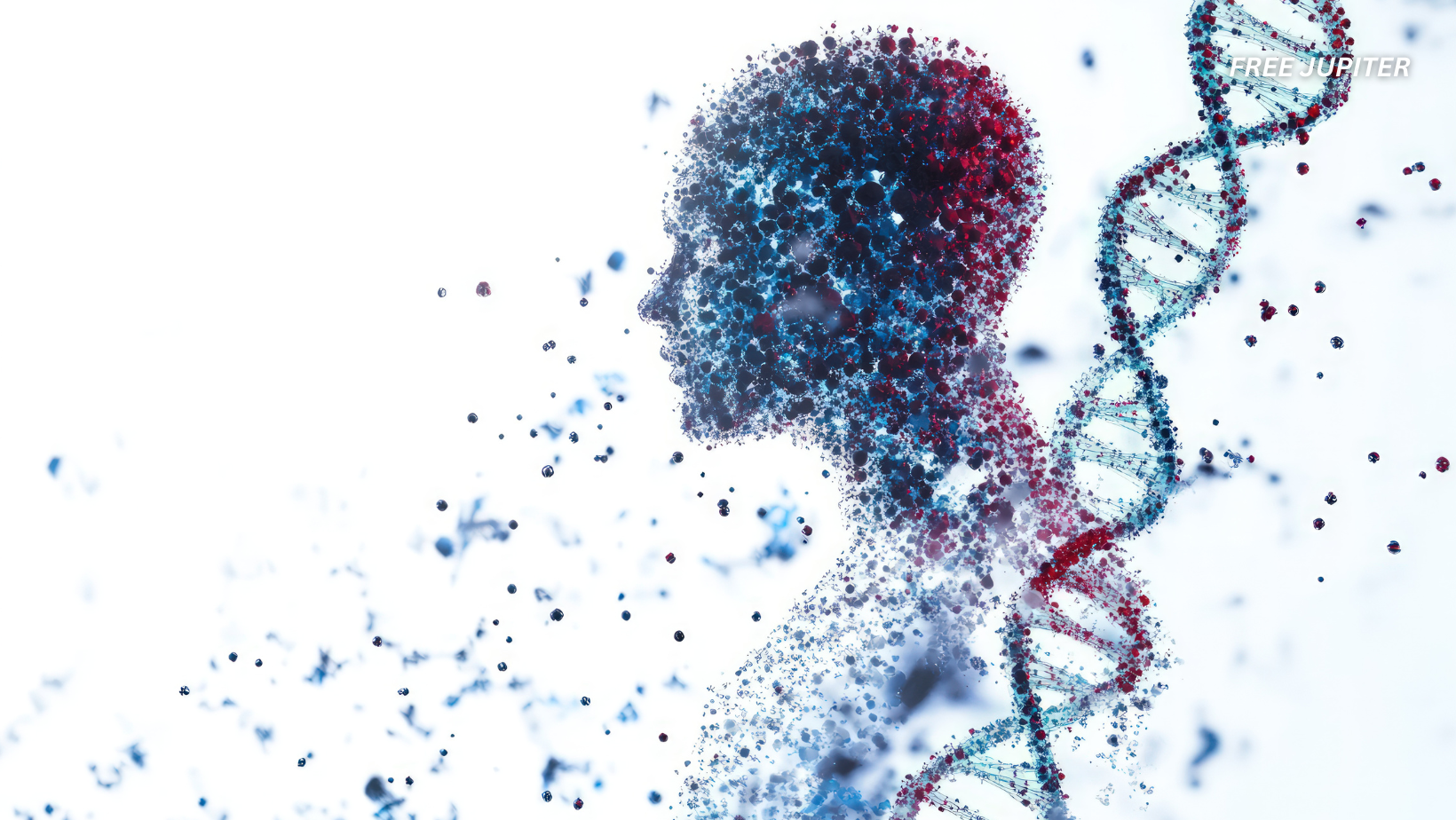Friendly Note: FreeJupiter.com is a place for curious minds and fun discoveries 🌌✨ But we’re a general information site, not a medical guide. Always double-check the facts—and when it comes to your health, check in with a professional too! 💙
For decades, scientists treated large chunks of our DNA like the weird attic of a family home—filled with old, dusty relics no one quite knew what to do with. These sequences were dismissed as “junk DNA,” leftovers from ancient viruses that invaded our ancestors’ genomes and never quite left. They were believed to have no function, just floating around in our genetic blueprint like a forgotten to-do list.
But as it turns out, this so-called genetic junk may have been hiding some serious superpowers all along.
A new international study—bringing together researchers from Japan, China, Canada, and the United States—has shed new light on a particular family of DNA sequences called MER11. Once considered genomic clutter, these viral fragments are now suspected of playing crucial roles in how our genes switch on and off, particularly during the early stages of human development.
🧬 Wait, What Is “Junk” DNA Anyway?
To understand how huge this finding is, let’s rewind a bit.
Only about 1–2% of your DNA actually codes for proteins—the biological workhorses that keep your cells and body functioning. The rest? Well, that’s where “junk DNA” comes in. For years, scientists had no idea what the other 98% was doing. Many believed it was just filler—genetic gibberish, leftovers from evolution, or remnants of long-extinct viruses.
Among the most notorious freeloaders in this category are transposable elements (TEs)—sometimes called “jumping genes.” These are segments of DNA that can copy and paste themselves into new locations within the genome. Imagine if you could duplicate your entire house and plant it down in another neighborhood with no warning—that’s kind of how TEs operate in your genome.
Over millions of years, these elements have inserted themselves in thousands of places across human DNA. They now make up nearly half of the human genome. And until recently, many researchers believed they just sat there quietly, doing nothing.
Turns out, they’ve been quietly running genetic background operations the whole time.
Read more: Researchers Have Now Identified Four Distinct Types Of Autism
🧠 MER11: The Underdog of DNA
One TE family that has recently taken the spotlight is called MER11—a group of viral-origin DNA sequences that have been hopping around primate genomes for roughly 40 million years. MER11 is part of a broader class of TEs called LTR retrotransposons. These sequences originally came from viruses that, instead of killing their hosts, managed to become part of our genetic code.
Unlike some older transposable elements that have been better studied, MER11 had long stayed under the radar. That’s because its repetitive, copy-paste nature makes it difficult for traditional gene-mapping tools to detect and study it accurately.
But thanks to a fresh classification system developed by the study’s researchers, MER11 finally got a proper inspection.
Using evolutionary history as a guide, scientists grouped MER11 into four subfamilies—MER11_G1 through MER11_G4—ranging from the oldest to the youngest. This system allowed them to track the changes these sequences have undergone over time and to investigate how each subgroup behaves in the human body.
🔬 Junk DNA Isn’t Just Hanging Around—It’s Flipping Switches
The team’s experiments uncovered something astonishing: MER11 segments—especially the youngest ones—are far from inactive.
Using a technique called lentiMPRA (short for lentiviral massively parallel reporter assay), scientists tested nearly 7,000 MER11 sequences in human stem cells and neural cells. This tool allows researchers to measure how strongly certain pieces of DNA can activate nearby genes.
The result? MER11, particularly the MER11_G4 subfamily, showed strong gene-activating potential, especially in the cells that are responsible for forming tissues and organs during early development.
Think of MER11 as a kind of “molecular light switch.” Depending on where it’s located in the genome, it can help switch nearby genes on or off, guiding stem cells as they become brain cells, heart cells, or other specialized types.
🧪 What Makes MER11 Special?
MER11 isn’t just a gene switch—it’s a very picky one.
The youngest MER11 sequences (G4) were found to contain transcription factor binding sites—essentially docking stations where regulatory proteins can latch on. These proteins control which genes are read and translated, based on environmental cues and developmental timing.
What’s more, MER11_G4 appears to be primed for brain development. The study found that in neural progenitor cells (the early-stage cells that eventually become neurons), MER11 was highly active. It was especially involved in gene networks tied to neurodevelopment—suggesting it may help steer the brain’s early formation like a behind-the-scenes conductor.
This discovery could open doors to understanding neurological diseases and developmental disorders, especially those tied to misregulated gene activity.
Read more: New Investigation Reveals Deadly Side Effect Linked to Popular Weight-Loss Drugs
🧬 Across Species: A Key to Evolution?
But it doesn’t stop with humans.
The researchers also looked at how MER11_G4 appears in other primates—such as chimpanzees and macaques—and found subtle differences in the DNA sequence across species. These tiny variations could affect how genes are expressed in each animal, hinting that MER11 might play a role in speciation—the process that leads one species to split into another over time.
According to Dr. Xun Chen of the Chinese Academy of Sciences, “This group [MER11_G4] gained different regulatory functions through sequence changes and contributes to speciation.”
In other words, these once-dismissed viral scraps may be partly responsible for what makes humans different from chimps, and chimps different from macaques.
🧬 Not the Only Study to Debunk the “Junk” Label
This isn’t the first time researchers have poked holes in the “junk DNA” myth.
A 2012 project called ENCODE (the Encyclopedia of DNA Elements) shocked the scientific world when it claimed that as much as 80% of the human genome had some kind of biochemical function. While this claim was (and still is) hotly debated, it forced scientists to reconsider the idea that non-coding DNA is useless.
Another fascinating example is the LINE-1 element, another type of transposable element, which has been implicated in brain plasticity, aging, and even cancer. Some researchers believe that the reactivation of these sequences could influence how the brain adapts and changes—or, in some cases, how it malfunctions.
Even telomeres—the protective caps on the ends of chromosomes—are made of repetitive sequences that were once shrugged off as junk. Now we know they’re critical for cell aging and longevity.
🧠 Could This Lead to Medical Breakthroughs?
Understanding how MER11 and other TEs influence gene expression could revolutionize everything from gene therapy to regenerative medicine.
If scientists can harness these elements’ ability to control genes, they could develop new treatments for diseases like Parkinson’s, Alzheimer’s, or certain cancers, which are often tied to faulty gene regulation. They might also improve methods for growing tissues and organs in the lab using stem cells.
We’re only just beginning to crack open this vast “junk drawer” of the genome—and inside may be some of biology’s best-kept secrets.
Read more: Can Adults Really Grow New Brain Cells? This New Study May Have the Final Answer
🔍 So, What Have We Learned?
The study of MER11 is more than just a fascinating science story—it’s a humbling reminder that nature rarely wastes anything. What was once written off as obsolete may turn out to be one of the most elegant regulatory systems in our bodies.
Rather than seeing junk DNA as a pile of genetic leftovers, we might be better off thinking of it as an ancient toolkit, passed down through eons, refined by evolution, and still hard at work shaping who we are—cell by cell, gene by gene.
In the end, what we don’t understand often gets labeled as “junk.” But as this research shows, sometimes it’s the misunderstood parts of our biology that end up being the most profound.
Disclaimer: The information in this article is for general informational purposes only and is not medical advice. We are not doctors, and this website is run as a family hobby project. Always consult a qualified healthcare professional before making decisions about your health. Please fact-check any claims and use this content as a starting point, not a substitute for professional guidance.










